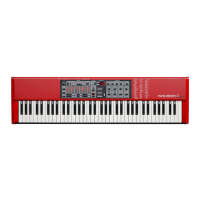Edit Menu
Select All [Ctrl+A]
This command will select all available items,
e.g. all the audio files or all the Sample Instruments.
Instrument Menu
Generate And Download
[Ctrl+G]
Creates a Sample Instrument
from the current Project and
stores it on the hard drive as
an .nsmp file. The Sample
Instrument will also be downloaded to the first available location in a
connected Nord Electro 3.
This process automatically encodes the samples with Clavia’s propri-
etary lossless compression algorithm, in order to reduce the sizes of
the samples. Samples will also be cropped before the sample start
points and after the loop end marker.
The duration of this process may take several minutes depending on
the amount of samples being used. You can use this file to share your
Sample Instrument with other Nord Wave or Nord Electro 3 users.
Generate Only [Ctrl+Y]
Creates a Sample Instrument from the current Project and stores it on
the hard drive as an .nsmp-file. This process automatically encodes the
samples with Clavia’s proprietary lossless compression algorithm, in
order to reduce the sizes of the samples.
The audio will also be cropped before the start points and after the
loop end marker. The duration of this process may last several minutes
depending on the amount of samples being used. The file is saved in
the same folder as your Project. Use this file type if you want to share
your Sample Instrument with other Nord Wave or Nord Electro 3 users.
Settings Menu
Audio...
Brings up the Audio Settings dialog box where you
select the driver for any audio card that is con-
nected to or installed in your computer. The output
level can also be set in this dialog. The selected audio card will be used
to play back samples by the Nord Sample Editor.
The Nord Sample Editor is compatible with Direct X drivers on a XP or
Vista system, and with the native Mac OSX drivers.
Manager Menu
Sound Upload
Use this function to upload
one or several sounds from the
Nord Electro 3 to the computer hard
drive
Sound Download
Use this function to download one or
several Sample Instruments from the
computer hard drive to the Nord Electro 3.
Delete
Allows you to delete a selected Sample Instrument from the
Nord Electro 3 memory.
Show Free Locations
When this option is checked, the list will show all the available locations
in the memory and not only the occupied ones. This will for instance
make it easier to drag a file to a specific free location in the middle of
the list. If this is unchecked, only the occupied locations will be shown.
Refresh
This function refreshes the content of the current window in the Nord
Sample Editor.
Clean Deleted Space
This function will clean up the space where any deleted Sample
Instruments have been before they were removed. If nothing has been
deleted, this button will be blanked out.
Format
This is a radical function; it will format the entire Sample memory and
prepare it for some brand new content. You will be asked to confirm
this action.
Help Menu
About...
Brings up the About box with information regarding
the version of the Nord Sample Editor.
Tab Reference
Each of the tabs opens up a set of functions that will assist you in map-
ping the samples, setting the start point of samples, loop the samples
and to manage the Sample Instruments in the Flash memory in the
Nord Electro 3.
You can select the different tabs one after each other, by typing
Ctrl+Tab on the computer keyboard.
Common area
The common area will be present at the top of all the tabs except
for the Manager tab. It contains functions that are used to view the
mapping, to change the focus of the samples, to generate a Sample
Instrument and to start and stop playback.
The Keyboard Grid
The Keyboard Grid represents the total keyboard range that the Zones
can cover - from F0 to C8. The middle C on the Nord Electro 3 - when
the Octave Shift is set to 0 - is the C4 key, MIDI Note Number 60.
A key with a • dot (
) indicates the Root Key - a sample is assigned to
this key and the sample plays back at its original pitch. The Zone that
this sample is assigned to is presented in a color scheme, with alter-
nating blue and gray colors to separate the Zones from each other.

